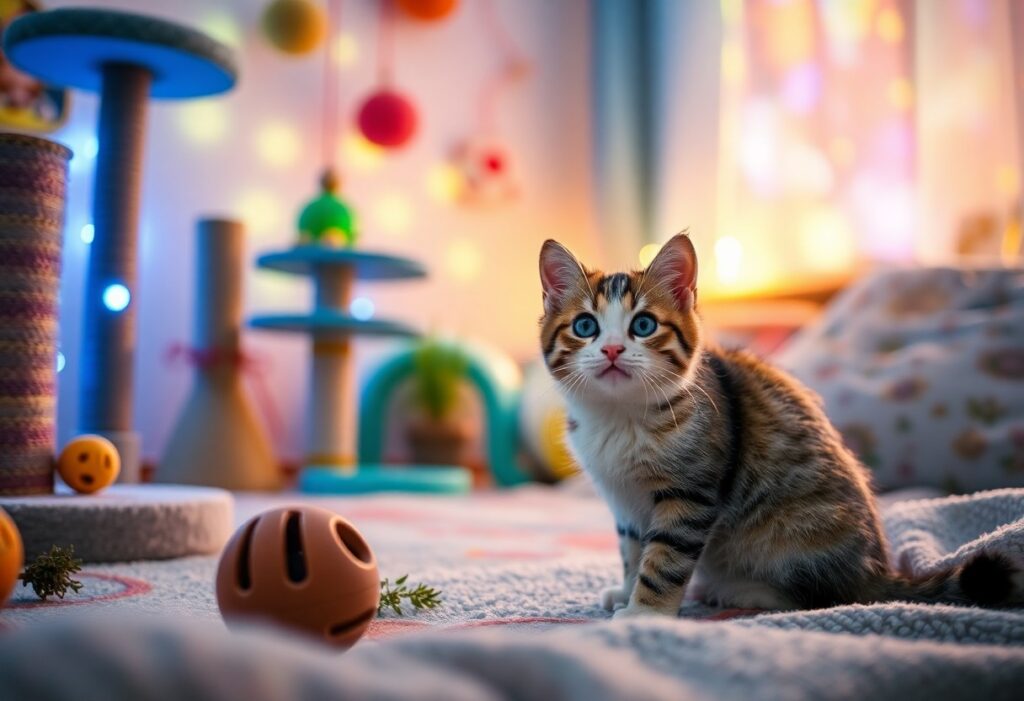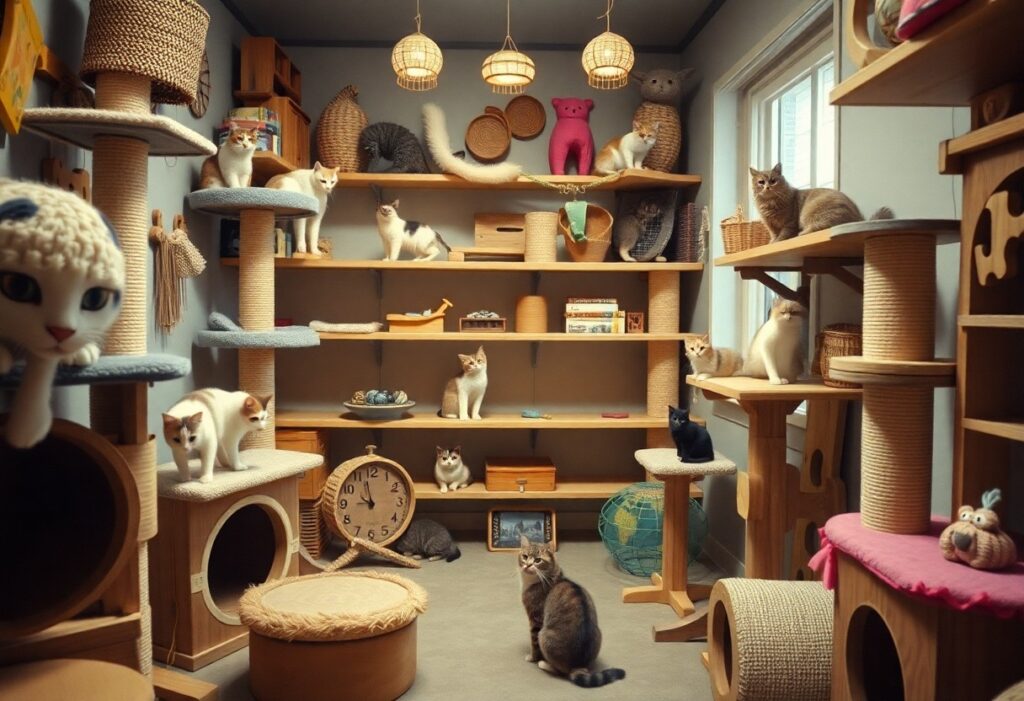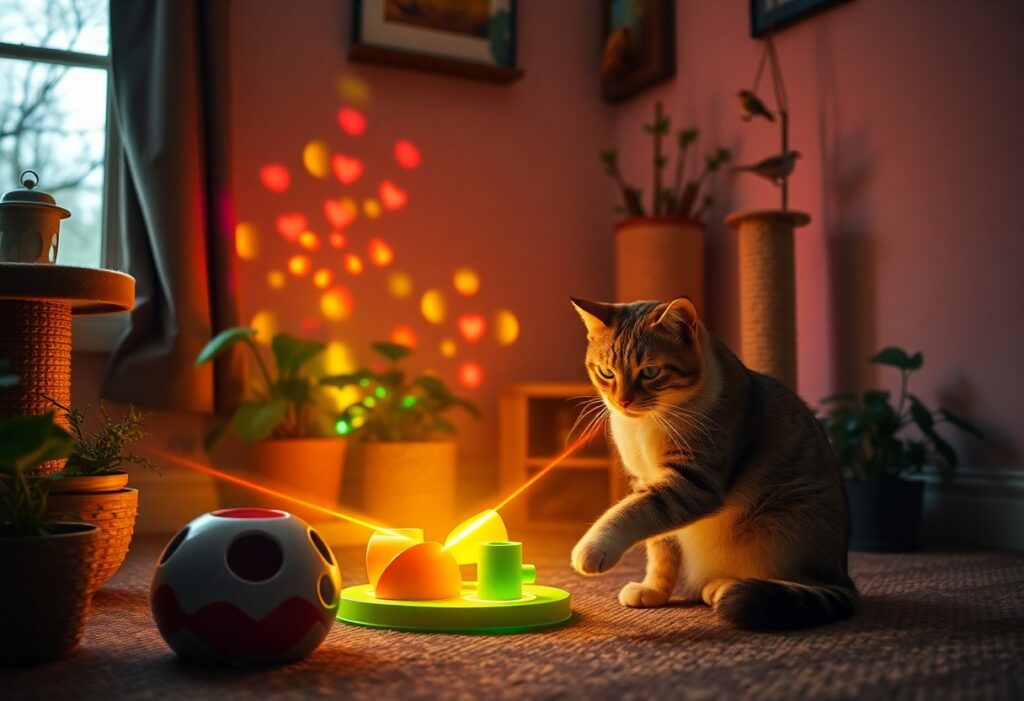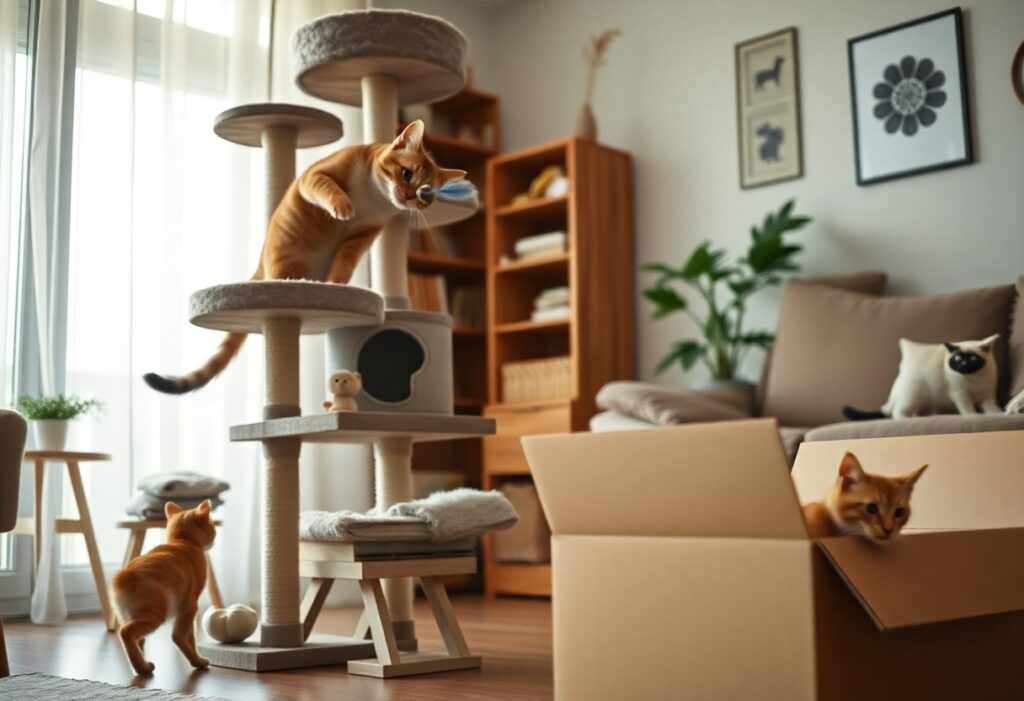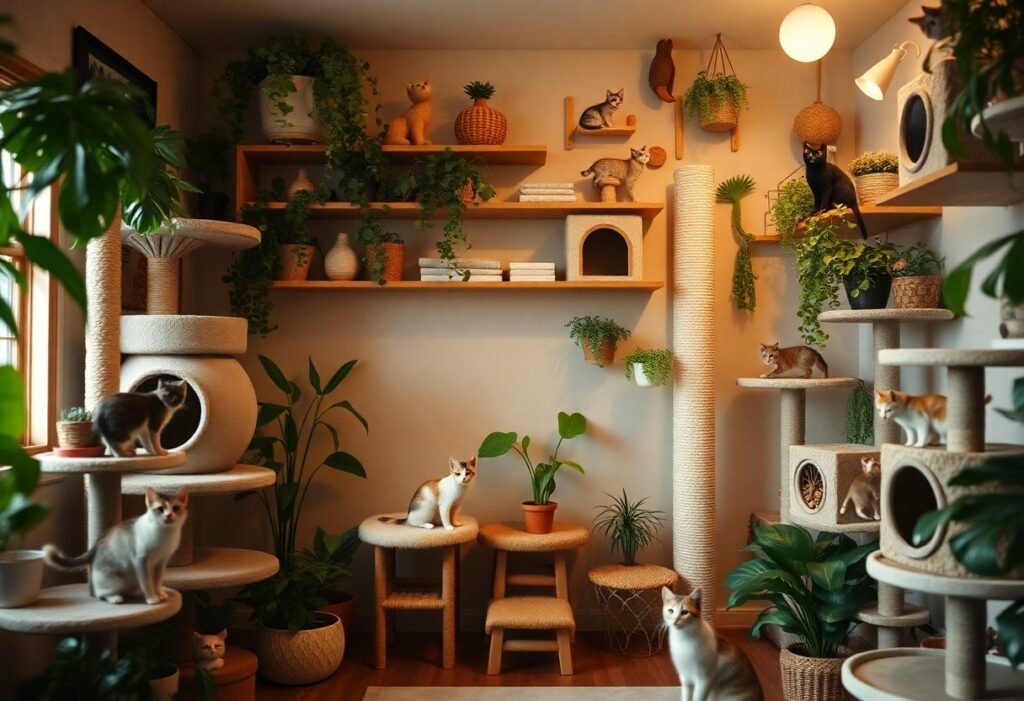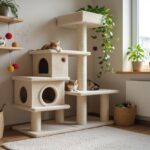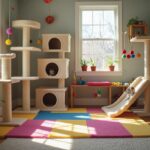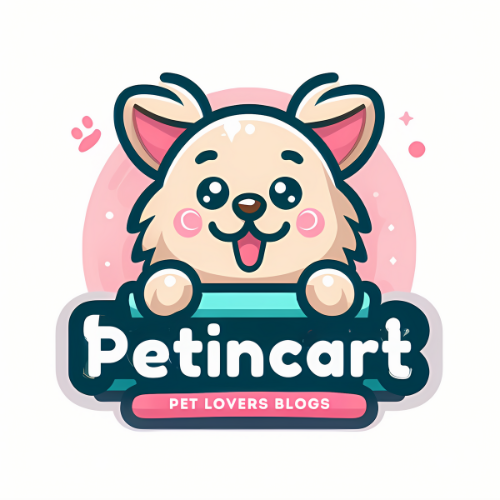Just as you strive to create a stimulating environment for your indoor cat, understanding how multi-sensory experiences can enhance their well-being is key. By incorporating a mix of sights, sounds, scents, and textures into their daily routine, you can foster an atmosphere that keeps them engaged and curious. This approach not only enriches their lives but also helps in preventing boredom and potential behavior issues. Join us as we explore effective strategies to make your cat’s world more enigmatic and fulfilling.
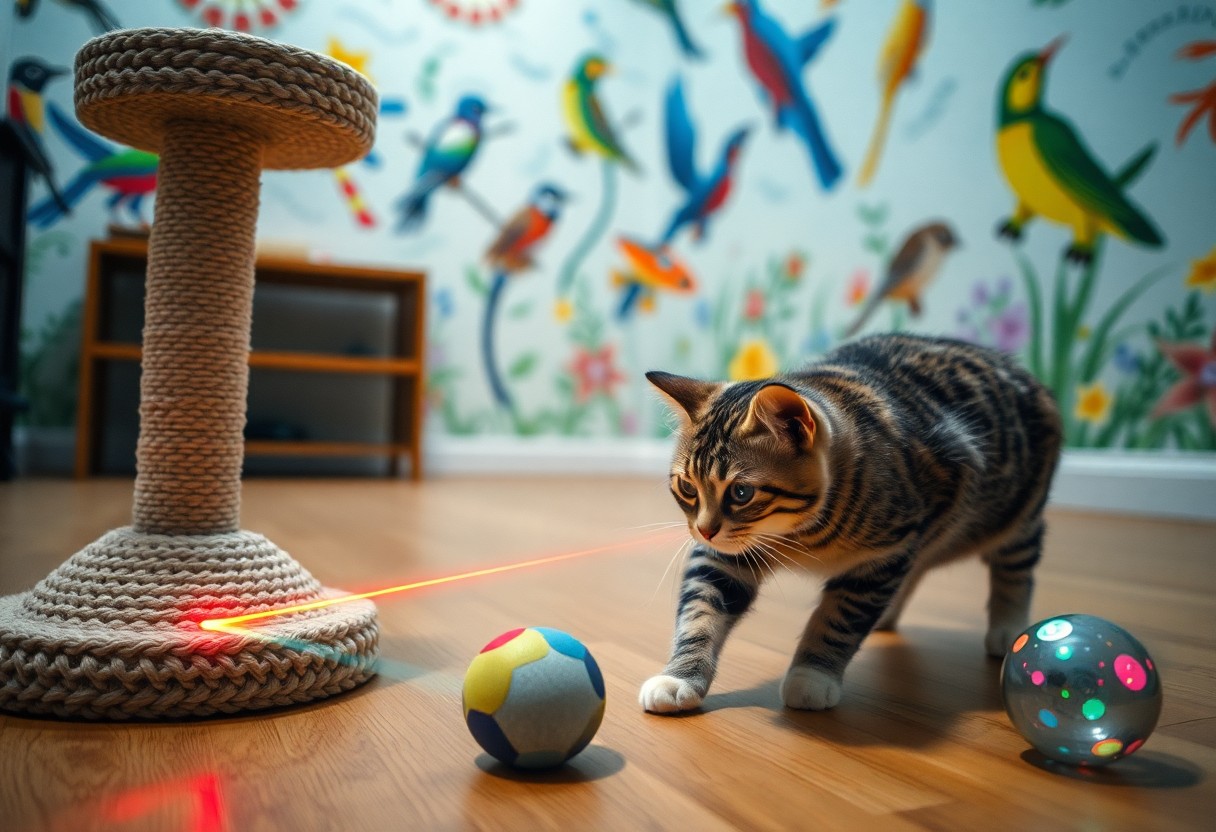
Key Takeaways:
- Multi-sensory experiences stimulate an indoor cat’s senses, enhancing their natural curiosity and encouraging playfulness through sights, sounds, smells, and textures.
- Engaging cats with varied stimuli can reduce boredom and stress, leading to healthier behaviors and stronger bonds between cats and their owners.
- Incorporating elements like puzzle feeders, sensory toys, and environmental enrichment creates a dynamic living space that keeps indoor cats mentally and physically active.
The Sensory Spectrum: What Cats Perceive Beyond Vision
Understanding your cat’s world begins with recognizing that their sensory perception extends far beyond mere sight. While vision is important, it is only one component of a rich tapestry of sensory input that encompasses smell, sound, and touch. These various modalities work together to provide your feline companion with a comprehensive understanding of their environment, making everyday experiences more vivid and engaging. By tapping into these perceptual layers, you can enrich your indoor cat’s life in delightful ways.
Exploring Feline Sensory Modalities
Felines are equipped with an array of sensory modalities that shape their interactions with the world around them. Their highly developed sense of smell allows them to detect pheromones and identify familiar scents from considerable distances, while acute hearing enables them to pick up high-frequency sounds that go unnoticed by humans. Additionally, their sensitivity to touch, especially through their whiskers and paws, allows them to navigate their surroundings with finesse. This multi-faceted perception offers a unique lens through which you can understand their behaviors and needs.
The Role of Smell, Sound, and Touch
Smell, sound, and touch serve as the bedrock of your cat’s sensory experience, often outweighing the importance of sight. With up to 300 million scent receptors in their noses, cats can detect odorants in parts per trillion, allowing them to interpret their surroundings far beyond what you can imagine. Their acute hearing can perceive frequencies as high as 64,000 Hz, allowing them to pick up on sounds made by potential prey—an vital skill for indoor hunters. Coupled with tactile sensitivity, especially through their specialized whiskers, touch becomes a crucial component of exploration and communication in your cat’s daily life.
The intertwined roles of smell, sound, and touch create a multi-sensory framework that drives your cat’s natural instincts and behaviors. For example, your cat may react to the rustling of a plastic bag not because of visual cues, but because they can hear critters inside or sense something intriguing through their whiskers. Similarly, introducing new scents—like catnip or specific toys—can stimulate exploration and curiosity. Understanding and leveraging these sensory modalities in your cat’s daily experiences can foster deeper engagement and prevent boredom, ultimately leading to a happier and more fulfilled indoor life.
Crafting an Immersive Environment: Building Multi-Sensory Play Spaces
Creating a multi-sensory environment is key to engaging your indoor cat’s instincts and providing stimulating experiences. This means designing play spaces that appeal to their sense of smell, sound, touch, and sight. You can incorporate various textures, scents, and visual elements into your cat’s habitat to enhance their exploration and playfulness, making every corner of your home a potential adventure. By curating an immersive environment, you stimulate their curiosity, keeping them active and engaged throughout the day.
Elements of a Stimulating Indoor Habitat
Your cat’s indoor habitat should feature a mixture of climbing structures, cozy hiding spots, and interactive areas. Incorporate natural elements like scratching posts, shelves, and ramps that entice your cat to explore different heights. Additionally, incorporating soft materials like blankets or carpets creates inviting textures for your cat to lounge on. Visual stimulation can be achieved through the strategic placement of cat trees or window perches, allowing your feline to observe outdoor activity.
How to Incorporate Cat-Specific Sensory Toys and Tools
Introduce a variety of sensory toys that encourage your cat to engage their natural instincts. Toys that mimic the movement of prey, like feather wands or laser pointers, are excellent for eliciting chase behavior. Likewise, consider toys that produce sounds, such as crinkle balls or catnip-filled mice, stimulating your cat’s auditory senses. You might also explore toys with different textures and scents that your cat can paw, bat, and investigate.
To effectively incorporate cat-specific sensory toys and tools, diversify your selection to appeal to your cat’s unique preferences. For instance, rotating toys weekly keeps their interest alive, preventing boredom. Installing a few interactive toys that dispense treats can also reward your cat’s curiosity while enhancing problem-solving abilities. Furthermore, choose toys made from safe, non-toxic materials to ensure your cat’s safety as they engage with them. Tailor your choices based on your cat’s personality; some cats may favor soft plush toys, while others might be more intrigued by those that rattle or emit a scent. This personalized approach cultivates a rich environment where your cat can thrive and explore with excitement.
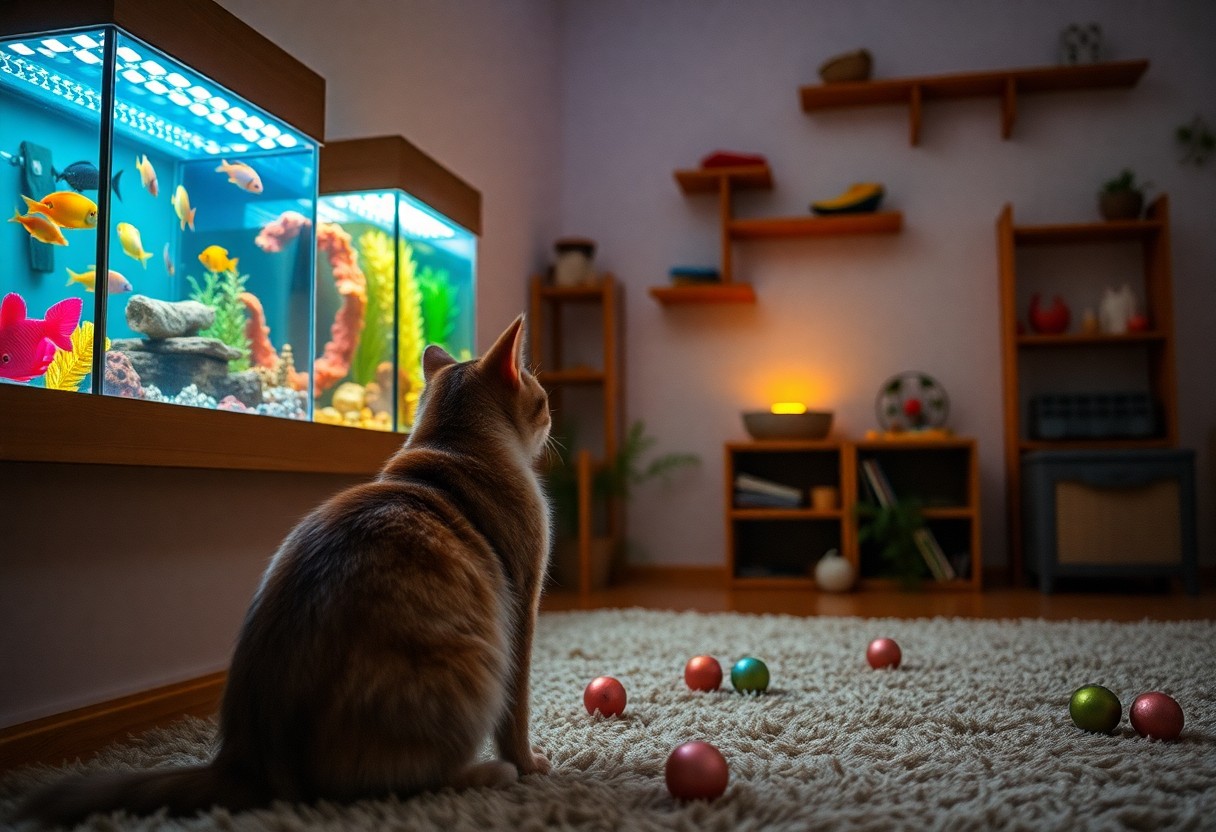
The Psychological Impact: Engagement through Enigma
Engaging your indoor cat through multi-sensory experiences not only stimulates their mind but also enhances their emotional well-being. When your cat encounters elements of mystery and uncertainty, this arouses their natural instincts and encourages exploration. Such experiences foster excitement and dedication, which can lead to a more fulfilled and content feline. Recognizing the psychological effects of these engagements leads to a deeper understanding of your cat’s needs, making your bond even stronger.
Theories of Curiosity and Mystery in Feline Behavior
The drive for curiosity in cats has long fascinated behaviorists, with theories suggesting that the allure of mystery can stimulate mental engagement. Cats are inherently hunters; thus, they seek out and investigate novel stimuli within their environment. This tendency towards curiosity often leads them to explore hidden or changing elements, which not only represents their instinctual behavior but also enriches their psychological state, making them feel more in control of their domain.
The Role of Puzzles and Problem-Solving Activities
Puzzles and problem-solving activities serve as enriching tools to enhance your cat’s cognitive engagement. Introducing various challenges, such as treat-dispensing toys or interactive games, simulates hunting and fosters healthy exploration. Activities requiring your pet to think critically can help diminish boredom and prevent behavioral issues. These stimulating experiences not only tap into their natural instincts but also transform the indoor environment into an engaging playground.
Implementing puzzles and problem-solving games can significantly impact your cat’s overall behavior and development. For instance, treat balls that require batting around to release snacks provide not only a reward but also a sense of accomplishment. By rotating available puzzles or introducing new challenges, you maintain a level of mystery and keep your cat engaged, ensuring that their minds are stimulated and their interests piqued. Studies indicate that cats exposed to regular cognitive challenges demonstrate improved problem-solving skills and reduced stress levels, contributing to long-term mental health benefits.
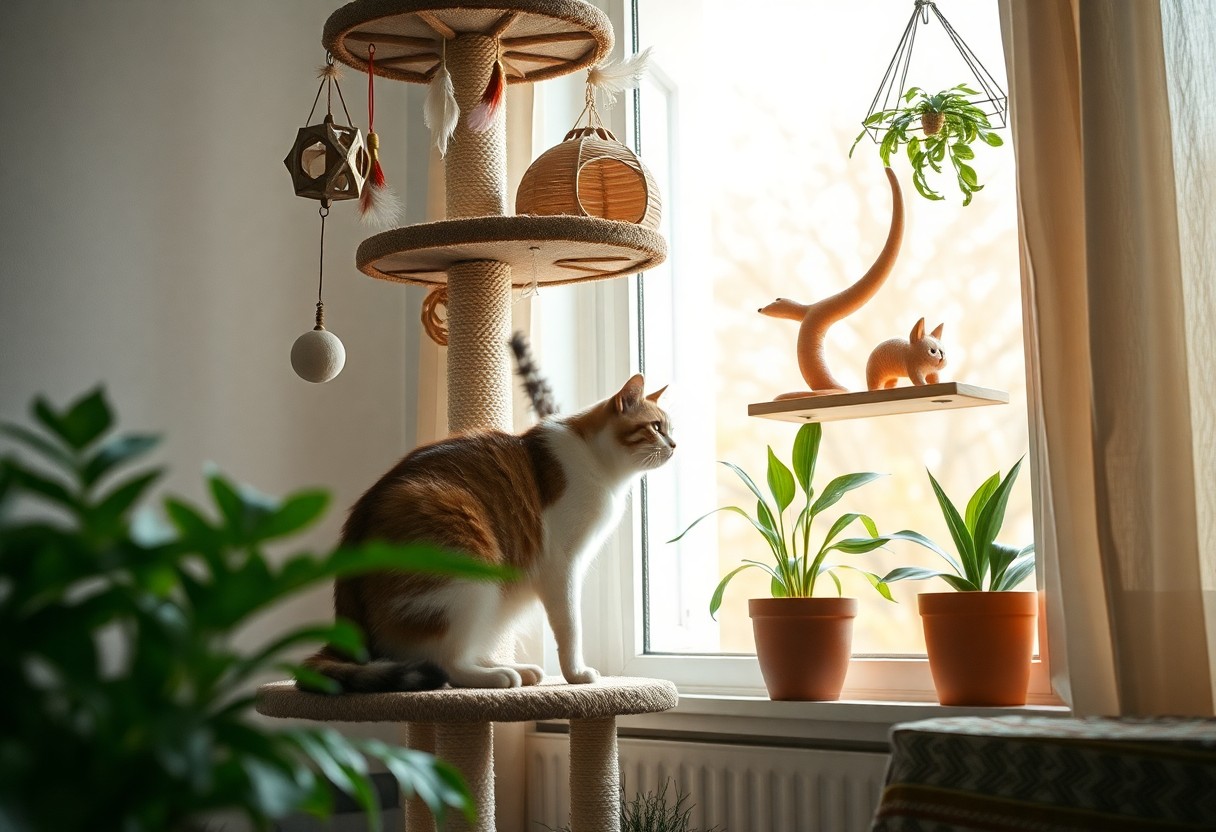
Enriching the Daily Routine: Practical Applications for Cat Owners
Integrating multi-sensory experiences into your cat’s daily routine not only entertains but also enhances their emotional and mental well-being. Try incorporating scent, sound, and touch during playtime, feeding, and exploration. For example, use toys with catnip or materials that create varied textures, and switch up the ambient sounds—such as nature sounds or soft music—to keep their environment stimulating and fresh.
Routine Activities Enhanced by Multi-Sensory Stimuli
Transform ordinary daily activities by adding layers of sensory engagement. During feeding time, consider using puzzle feeders to stimulate your cat’s mind and sense of taste. Playtime can evolve into a multi-sensory experience by incorporating toys that emit sounds, or crinkle. These enhancements not only keep your cat engaged but also reinforce natural hunting behaviors, which are necessary for their overall health and happiness.
Seasonal and Thematic Changes to Keep Engagement High
Regularly updating your cat’s environment with seasonal and thematic changes can spark curiosity and excitement. Rotating toys, introducing new scents related to the seasons (like pumpkin spice in fall), or decorating areas of your home can help maintain interest. For example, during winter, try creating a cozy corner with different fabrics for snuggling, enriching their tactile experience and keeping them warm.
Seasonal and thematic changes shouldn’t just be limited to visuals; consider adjusting toys and activities to reflect holidays or seasonal events. For Halloween, indulge your cat with treat-filled toys shaped like ghosts or pumpkins. In spring, you might introduce flower-scented scratching posts or interactive toys resembling birds. These transitions not only captivate your cat’s attention but also create opportunities for bonding and interaction, allowing you to engage more deeply with your feline companion while catering to their natural instincts and curiosity.
Fostering Bonds: How Multi-Sensory Experiences Improve Cat-Human Interaction
Multi-sensory experiences significantly strengthen the bond between you and your cat by fostering emotional connection and understanding. Engaging your feline friend with various stimuli, including scents, sounds, and textures, can create a deeper, shared experience. Not only does this enhance your cat’s mental stimulation, but it also promotes trust and security in your relationship. By catering to their natural instincts, you make interactive moments more enjoyable, leading to a more harmonious and fulfilling companionship.
Engaging Playtime: Strengthening the Human-Feline Connection
Incorporating multi-sensory elements into playtime can elevate the enjoyment and bonding you share with your cat. Whether it’s a feather wand that flickers through the air or toys that emit enticing sounds, these interactions engage your cat’s curiosity. As you play together, you foster a sense of teamwork and collaboration, transforming mundane moments into lasting memories that enhance your connection. Engaged play not only fuels your cat’s physical health but also deepens your emotional ties.
The Importance of Shared Experiences
Shared experiences, rich in multi-sensory interactions, serve as a foundation for building trust with your cat. Engaging in activities that stimulate their senses—from texture exploration with climbing trees to collaborative hunting games—creates a shared language between you and your feline. For instance, when you introduce new scents through catnip or herbal mixes, you encourage exploration and playfulness, allowing your cat to connect positive experiences with your presence. These shared moments build emotional resilience and reinforce your bond, making both you and your cat feel more secure and happy in the relationship.
To wrap up
The incorporation of multi-sensory experiences in your indoor cat’s environment significantly enhances their engagement and curiosity. By appealing to their sense of sight, sound, smell, and touch, you stimulate their natural instincts and keep them mentally active. This not only cultivates an air of mystery and excitement in their daily lives but also strengthens your bond with them. Engaging your cat in diverse experiences can lead to a happier, more fulfilled pet, benefiting both their emotional well-being and your shared companionship.
Q: What are multi-sensory experiences for indoor cats?
A: Multi-sensory experiences for indoor cats refer to activities and environments that engage various senses such as sight, sound, smell, and touch. These experiences can include providing interactive toys, varied textures in their environment, stimulating scents, and dynamic visual elements like moving images or light patterns. By tapping into their natural instincts and curiosity, these experiences can make the indoor environment more enriching, thus fostering a more engaging lifestyle for indoor cats.
Q: How do these experiences contribute to a cat’s mental engagement?
A: Multi-sensory experiences can stimulate a cat’s brain by providing challenges and opportunities for exploration. For instance, toys that make sounds or require the cat to solve puzzles can encourage cognitive engagement. The introduction of different textures can evoke natural behaviors like scratching or playing, which keeps the cat mentally active. Altogether, these sensory stimuli can help alleviate boredom, reduce stress, and promote a more enriched living space, leading to a happier, more engaged feline.
Q: Can multi-sensory experiences help in reducing behavioral problems in indoor cats?
A: Yes, engaging indoor cats with multi-sensory experiences can significantly reduce behavioral problems. Cats often express frustration through destructive behaviors, excessive meowing, or litter box issues due to a lack of stimulation. By diversifying their surroundings with various textures, sounds, and interactive toys, owners can redirect that energy into more positive outlets like play and exploration. Such enrichment can help maintain a balanced and content indoor cat, minimizing the likelihood of behavioral challenges.
